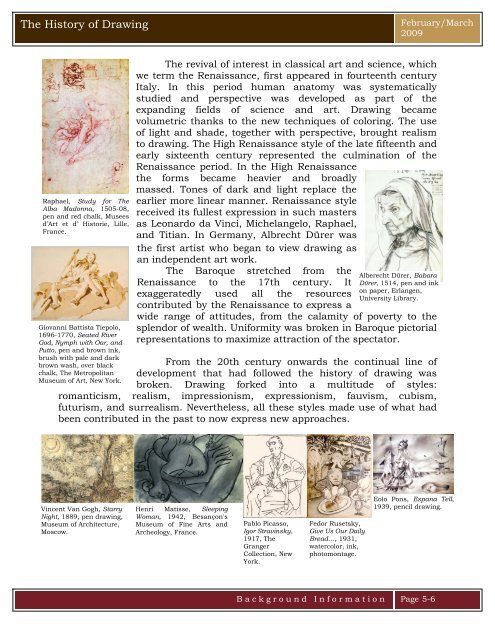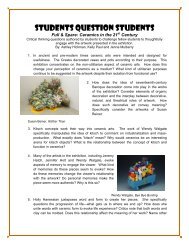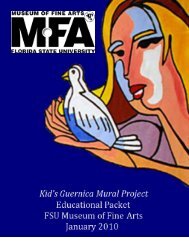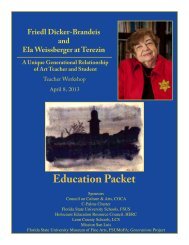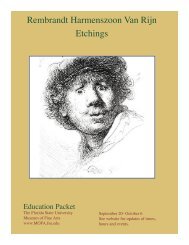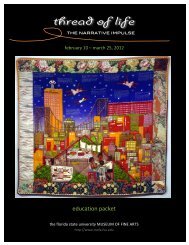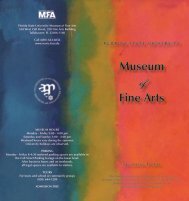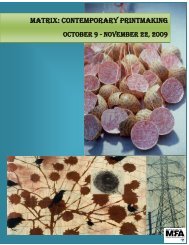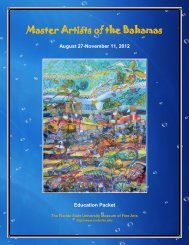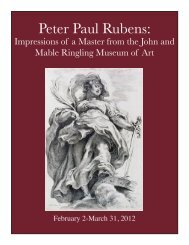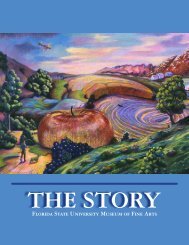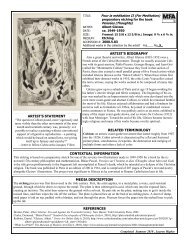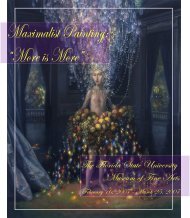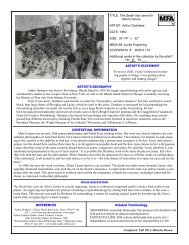old master drawings - Museum of Fine Arts - Florida State University
old master drawings - Museum of Fine Arts - Florida State University
old master drawings - Museum of Fine Arts - Florida State University
You also want an ePaper? Increase the reach of your titles
YUMPU automatically turns print PDFs into web optimized ePapers that Google loves.
The History <strong>of</strong> DrawingFebruary/March2009Raphael, Study for TheAlba Madonna, 1505-08,pen and red chalk, Museesd’Art et d’ Historie, Lille,France.Giovanni Battista Tiepolo,1696-1770, Seated RiverGod, Nymph with Oar, andPutto, pen and brown ink,brush with pale and darkbrown wash, over blackchalk, The Metropolitan<strong>Museum</strong> <strong>of</strong> Art, New York.The revival <strong>of</strong> interest in classical art and science, whichwe term the Renaissance, first appeared in fourteenth centuryItaly. In this period human anatomy was systematicallystudied and perspective was developed as part <strong>of</strong> theexpanding fields <strong>of</strong> science and art. Drawing becamevolumetric thanks to the new techniques <strong>of</strong> coloring. The use<strong>of</strong> light and shade, together with perspective, brought realismto drawing. The High Renaissance style <strong>of</strong> the late fifteenth andearly sixteenth century represented the culmination <strong>of</strong> theRenaissance period. In the High Renaissancethe forms became heavier and broadlymassed. Tones <strong>of</strong> dark and light replace theearlier more linear manner. Renaissance stylereceived its fullest expression in such <strong>master</strong>sas Leonardo da Vinci, Michelangelo, Raphael,and Titian. In Germany, Albrecht Dürer wasthe first artist who began to view drawing asan independent art work.The Baroque stretched from theRenaissance to the 17th century. Itexaggeratedly used all the resourcescontributed by the Renaissance to express aAlberecht Dϋrer, BabaraDϋrer, 1514, pen and inkon paper, Erlangen,<strong>University</strong> Library.wide range <strong>of</strong> attitudes, from the calamity <strong>of</strong> poverty to thesplendor <strong>of</strong> wealth. Uniformity was broken in Baroque pictorialrepresentations to maximize attraction <strong>of</strong> the spectator.From the 20th century onwards the continual line <strong>of</strong>development that had followed the history <strong>of</strong> drawing wasbroken. Drawing forked into a multitude <strong>of</strong> styles:romanticism, realism, impressionism, expressionism, fauvism, cubism,futurism, and surrealism. Nevertheless, all these styles made use <strong>of</strong> what hadbeen contributed in the past to now express new approaches.Vincent Van Gogh, StarryNight, 1889, pen drawing,<strong>Museum</strong> <strong>of</strong> Architecture,Moscow.Henri Matisse, SleepingWoman, 1942, Besançon's<strong>Museum</strong> <strong>of</strong> <strong>Fine</strong> <strong>Arts</strong> andArcheology, France.Pablo Picasso,Igor Stravinsky,1917, TheGrangerCollection, NewYork.Fedor Rusetsky,Give Us Our DailyBread…, 1931,watercolor, ink,photomontage.Eolo Pons, Espana Tell,1939, pencil drawing.BackBackground Information Page 5-6


